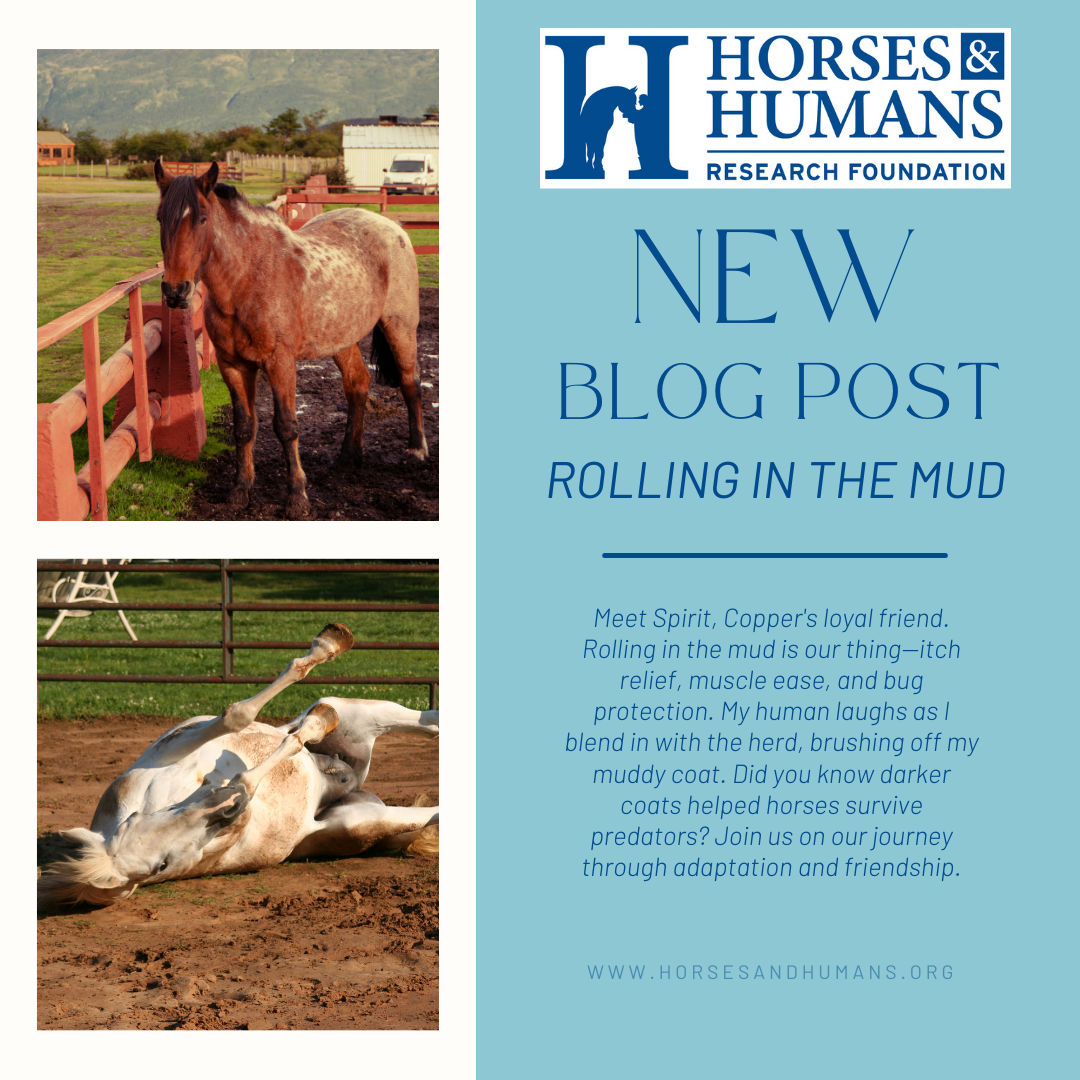Rolling in the Mud! by Kathleen Choe
Meet Spirit, Copper's loyal friend. Rolling in the mud is our thing—itch relief, muscle ease, and bug protection. My human laughs as I blend in with the herd, brushing off my muddy coat. Did you know darker coats helped horses survive predators? Join us on our journey through adaptation and friendship.
Spirit
A little strawberry roan appaloosa who loves to rock and roll!
By Kathleen Choe, M.A.
My name is Spirit, and I am Copper’s best friend. (My herd mate Sterling also thinks he is Copper’s best friend. I think he just bosses Copper into staying close by him so he can swish flies off of Sterling’s face with his luscious tail. It is perfect for swishing flies away! I try to position myself where I can benefit too.)
Star used to be my best friend, but she left us last year . . . my human said she was suffering too much to remain on this earth with us. I knew Star was not well and didn’t leave her side . . . until she left mine. I kept to myself for a while, but Copper kept nosing his way into my space and it felt good to have a friend again. I stopped squealing and stamping my hoof at him and let him stay.
My favorite thing to do is to find the perfect patch of ground, especially after it rains, and have a good roll. (A good roll is where you can flip from one side to the other without getting stuck in the middle! Chief has to roll on one side and then get up and go down on his other side because he has not mastered the art of the flip).
Rolling feels good for so many reasons: it scratches places where I feel itchy, relieves muscle soreness and tension, removes dried sweat and dead skin, and leaves a layer of dirt on my skin to protect against the sun and insects that want to bite me. Sometimes I roll if I’m feeling playful, or if my tummy hurts, but my human interferes with this kind of rolling and walks around with me instead to prevent something she calls “colic.”
The perfect roll involves first looking around to make sure there are no predators or other scary things around me in the environment, then pawing the ground to see if it is soft and squishy and free from rocks or twigs that might hurt my back. I drop to my knees, then flop down on one side and rub it in the dirt several times before flipping over to the other side. I make sure to press both sides of my face into the ground too for even coverage. Then I push up so that my belly is resting on the ground and rock back and forth to itch that spot in the middle that I can never seem to reach with my teeth or hooves. After I get back on all four legs, I shake all over and snort to blow out any dust that got in my nostrils. Sometimes I am so happy I trot away, throwing in a few bucks and leaps to express my joy!
When my human shows up after one of my rock and roll’s, she laughs and ask me if I am trying to blend in the with herd and hide from predators (I am the only light-colored horse in my pasture). She told me that a very long time ago my ancestors had to adapt to living in forests surrounded by predators and darker colored horses blended in better with this new environment. They had a better chance of survival than lighter colored horses. “Do you want to be a brown horse, Spirit?” she asks me when I’m covered in mud just the way I like to be. Then she gets out a curry comb and tries to brush off all the dirt I worked so hard to cover my body with! I don’t mind too much, because I like the attention and I know I can just go and roll again when she finishes brushing me . . .
Did you know:
Scientists know that every breed of horse carries the genes for the basic horse coat colors of bay, black, and chestnut and have learned through research that the black coat adapted into a more common color when climate change forced horses in Europe into forests full of predators approximately 11,000 years ago. After our most recent ice age, the climate began to warm resulting in plant life and forest regrowth. This forced many animals who relied on plants found in the ever-disappearing steppes and plains to adapt to new foods and move into forests, where there were predators like wolves, who could hide and attack more easily. Many species became extinct, including a then-abundant mammoth. But horses adapted to their new surroundings. Those horses of darker color where able to camouflage with the darker forests, avoid their predators, and resulted in those darker coat-color genes to be passed on to their offspring. In other words, darker horses were able to blend in with the forest, allowing them to “hide” from their predators in comparison to lighter or even white horses. Because more darker horses survived, they went on to have more offspring like themselves…darker in color.[i]
https://thehorse.com/155687/how-coat-color-adaptations-helped-ancient-horses-survive/

